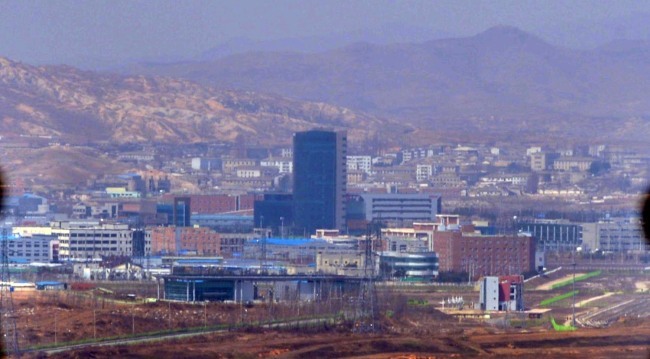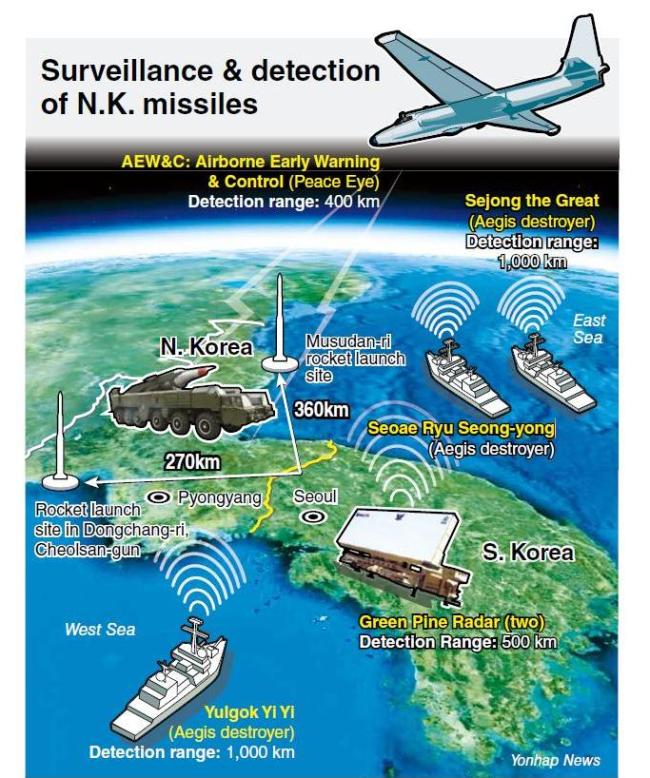Allied forces on high alert amid N.K. missile threats
Seoul officials say Pyongyang is ready for multiple missile launches; Washington calls threat ‘unhelpful’
By 윤민식Published : April 10, 2013 - 18:05
South Korea and the U.S. stepped up their intelligence and surveillance activities on Wednesday amid growing signs of North Korea’s imminent multiple missile launches.
The allied forces raised the Watch Condition, or Watchcon, by one notch to level 2, and bolstered their intelligence personnel. Intelligences indicated Pyongyang has finalized preparations to launch its Musudan intermediate-range missiles from its east coast. Seoul officials said.
The allied forces raised the Watch Condition, or Watchcon, by one notch to level 2, and bolstered their intelligence personnel. Intelligences indicated Pyongyang has finalized preparations to launch its Musudan intermediate-range missiles from its east coast. Seoul officials said.

“North Korea can fire missiles at any time now, if it has the political determination to do so,” a military source said, declining to be named.
Seoul officials believe Pyongyang could launch multiple missiles such as its Musudan, Scud and Rodong missiles on the same day.
“In addition to the two Musudan missiles spotted in the Wonsan area of (the North’s) Gangwon Province, we identified four to five transporter-erector-launchers (mobile launchers) around the Donghan bay spanning South Hamgyeong Province and Gangwon Province,” a senior government official told reporters.
The mobile launchers are known to be used to carry the North’s Scud or Rodong missiles.
Scud missiles with ranges of 300-500 km put South Korea within striking range while Rodong missiles with ranges of some 1,300 km and Musudan missiles with ranges beyond 3,000 km can strike Japan and Guam, respectively.

All three missiles have been deployed before while Taepodong-2 missiles with ranges of longer than 6,700 km are still under development. The intercontinental missiles are capable of striking the U.S. mainland.
In the past, Pyongyang launched multiple missiles in the same day. On July 5, 2006, it launched a Taepodong-2 missile, four Scud missiles and two Rodong missiles while on July 4, 2009, it fired five Scud missiles and two Rodong missiles.
Mobilizing their core intelligence, reconnaissance and surveillance assets including South Korea’s Aegis-equipped destroyers, the South Korean and U.S. militaries here kept closer tabs on North Korean movements.
The South Korean military ran a taskforce, consisting of some 10 senior officers, to prepare for the possible missile launch.
To better handle ballistic missile threats, Seoul seeks to establish the “Air and Missile Defense-Cell” by July. The AMD-Cell tasked with analyzing missile information gleaned from early warning satellites and radars, is a key part of the low-tier missile shield Seoul plans to build.
During a parliamentary session, Seoul’s Foreign Minister Yun Byung-se confirmed the possibility of North Korea launching missiles was “considerably high.”
“Based on our and U.S. intelligence, the missile could be the Musudan missile. Its range is around 3,500 km, but how far it will travel hinges on North Korea’s intentions,” he said.
Experts said the range of the missile can be adjusted according to the amount of the fuel, the angle at which it flies, and other factors.
Stressing its nuclear and missile capabilities had reached a “considerable level,” Yun warned another missile launch would constitute a violation of U.N. Security Council resolutions that ban any missile tests by the provocative state.
“Upon any additional launch, the UNSC would immediately convene. As we all need to thoroughly analyze the nature of the missile launch, it is yet difficult to predict what kinds of measures the UNSC would adopt for another launch,” he said.
The minister also underscored that Washington would not hold talks with Pyongyang should it continue to set off provocations and refuse to show sincerity in the multilateral efforts to denuclearize it.
“The U.S. stresses that inter-Korean talks should precede any talks between Washington and Pyongyang, (though be held) in close coordination with Washington,” he said.
During a Senate Armed Services Committee session, Adm. Samuel Locklear, the commander of U.S. Pacific Command, said the U.S. military has the ability to intercept a North Korean ballistic missile. But he added that a decision on whether a missile should be intercepted would be based on where it is aimed and expected to land.
“I believe we have the ability to defend the homeland, Guam, Hawaii and defend our allies,” said Locklear, pointing out that the reclusive state’s nuclear weapons and missiles posed a “clear threat” to the U.S. and its regional allies.
The Pentagon plans to deploy a land-based “terminal high-altitude area defense system” to Guam in the coming weeks as a precautionary move to counter a possible missile attack.
It has also unveiled its plan to strengthen missile defense against the North by installing 14 additional ground-based interceptors at its bases in Alaska and California by September 2017.
White House spokesperson Jay Carney characterized North Korea’s nuclear war threat as “unhelpful, concerning and provocative,” noting it was a pattern of combative statements and behavior that the leadership in Pyongyang has shown for years.
Another U.S. official said North Korea’s test missile launches could occur without Pyongyang issuing a standard warning to commercial aviation and maritime authorities.
“We hope they issue a notification, but at this point we don’t expect it. We are working on the assumption they won’t,” the anonymous official was quoted by CNN as saying.
By Song Sang-ho
(sshluck@heraldcorp.com)








![[Today’s K-pop] BTS pop-up event to come to Seoul](http://res.heraldm.com/phpwas/restmb_idxmake.php?idx=644&simg=/content/image/2024/04/17/20240417050734_0.jpg&u=)
![[Graphic News] More Koreans say they plan long-distance trips this year](http://res.heraldm.com/phpwas/restmb_idxmake.php?idx=644&simg=/content/image/2024/04/17/20240417050828_0.gif&u=)






![[KH Explains] Hyundai's full hybrid edge to pay off amid slow transition to pure EVs](http://res.heraldm.com/phpwas/restmb_idxmake.php?idx=652&simg=/content/image/2024/04/18/20240418050645_0.jpg&u=20240419100350)

